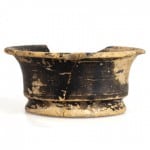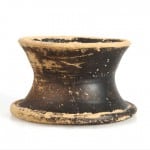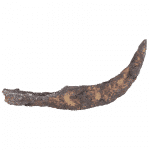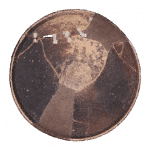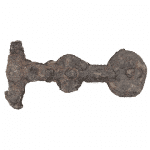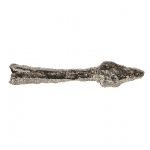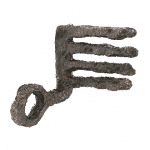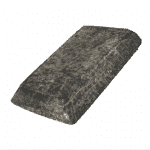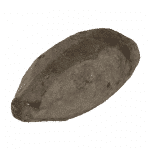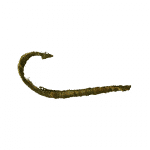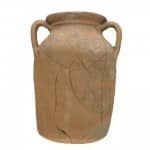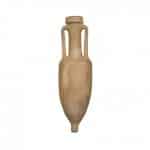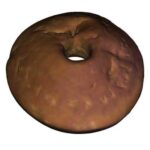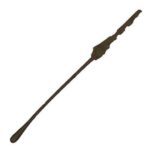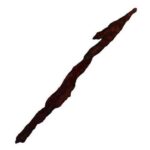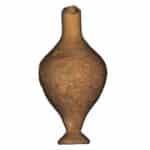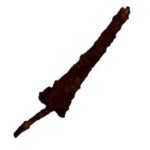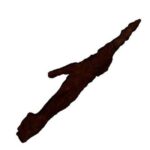Virtual museum
The use of new technologies has not only helped further investigation of the Puig Ciutat site in the digitisation, management, analysis and interpretation of the field data, but also to publicise it. In this respect, 3D technology offers the chance to present interactive models of archaeological elements and sites that simplify the transmission of complex scientific content and results. For this reason, the main object of this section is to present 3D models of the items retrieved over several archaeological seasons.
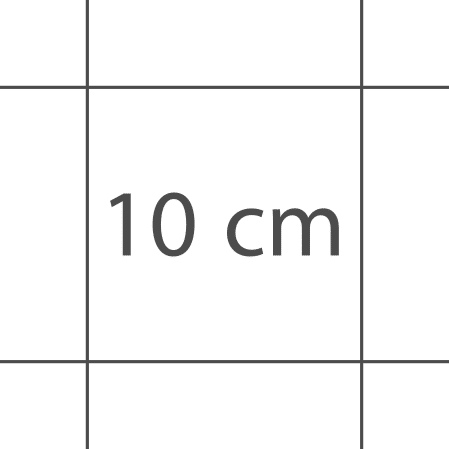
Inventory number: PC10-2005-4
Name of the object: small goblet or cup.
Material: ceramic.
Production: black burnish from Cales.
Type: ware
Shape: Lamb. 2
Dimensions: height: 4 cm. diametre: 9,7 cm.
Chronology: 125-25 BC.
Survey: july 2010.
Provenance: sector 2.
Description: Small goblet or tapering cup with concave sides and a marked inflection at the bottom. It shows no decoration. For individual use for consuming liquids.
For more information click here.
Inventory number: PC10-2005-3
Name of the object: pyx
Material: ceramic
Production: black burnish from Cales
Type: common ware
Shape: Lamb. 3
Dimensions: height: 4,8 cm. diametre: 8,7 cm
Chronology: 125-25 BC
Survey: july 2010
Provenance: Sector 2
Description: A small pyx with tapered edge and concave sides without a rim and with an annular foot. It has no decoration. For individual use for consuming liquids.
For more information click here
Inventory number: PC13-2130-OC72
Name of the object: Pruner
Material: metal, iron
Type: tool
Dimensions: maximum length: 18,5 cm; width: 2,7 cm; thickness: 0,4cm.
Chronology: Roman Late Republic
Survey: july 2013
Provenance: sector 10
Description: Small scythe or billhook located in a domestic context. This type of small scythe or pruning knife are associated with work on vines or trees such as olive trees,
Inventory number: PC12-2084-120
Name of the object: plate reparaired with lead staples
Material: ceramic
Production: black burnish from Cales.
Type: ware
Shape: Lamb. 5/7.
Dimensions: diametre of 33cm
Chronology: 125-25 BC
Survey: julyl 2012
Provenance: sector 7
Description: Large black glazed plate or dish from Cales. This is an important item of tableware and is of some value. They are considered luxury products imitating the gold, silver or bronze tableware that not everyone could afford.
Inventory number: PC10-101-191
Name of the object: hilt of a bidiscoidal dagger
Material: metal, iron
Type: weaponry
Shape: bidiscoidal
Dimensions: length: 12cm maximum diametre: 6cm
Chronology: Roman Late Republic
Survey: july 2010
Provenance: SUPI 4
Description: Hilt of a bidiscoidal dagger still with the rivets that joined the two parts together. The blade has been lost. Using X-rays, it has been possible to see that the dagger had bronze decorations in the areas close to the rivets on the discs.
Inventory number: PC10-2005-508
Name of the object: head of a pilum catapultarium
Material: metal, iron
Type: weaponry
Dimensions: total length: 10,3cm; length of the body:7,1cm; length of the head: 3,2 cm. irregular diametre of the body: from 1,8 cm at the openeing, to 1,1 cm where the head starts. Maximum width at the base of the head: 1,6 cm. Weight: 60gr.
Chronology: Roman Late Republic
Survey: july 2010
Provenance: sector 2
Description: Square-sectioned compact, solid pilum catapultarium bolt with socket attachment to the shaft. Catapult bolts could be a very effective weapon for eliminating the defenders of a wall in a hypothetical siege.
Inventory number: PC10-2005-516
Name of the object: door key
Material: metal, iron
Type: daily use object
Dimensions: length (from the spikes to the outer part of the handle): 5 cm. length (from the spikes to the inner part of the handle): 4,7 cm. Irregular thickness (of the spikes): de 0,4 a 0,6 cm. Thickness (of the square handle): 0,7 x 1,2 cm. diametre of the ring: outer: 2,4 cm; inner: 1,5 cm.
Chronology: Roman Late Republic
Survey: july 2010
Provenance: sector 2
Description: Door key with four teeth, a short handle and a bow. Some of the teeth are slightly at an angle, which could have been caused in ancient times or due to the weight of the earth. The bow is large enough to carry it on one finger.
Inventory number: PC10-101-190
Name of the object: Sharpening stone or coticule
Material: lithic, basalt.
Type: daily use object
Shape: rectangular
Dimensions: 6 x 4 cm. Thickness: 1 cm.
Chronology: Roman Late Republic
Survey: july 2010
Provenance: SUPI 4.
Description: Rectangular sharpening stone, touchstone or coticule of basaltic tuff with bevelled edges
Inventory number: PC10-2005-539
Name of the object: Sling projectile
Material: metal, lead.
Type: weaponry
Shape: bi-conical Type 2b of Völling (1990)
Dimensions: length: 4,1 cm, width: 1,6 cm, weight: 45 gr
Chronology: s. I BC.
Survey: july 2010
Provenance: sector 2.
Description: Lead sling projectile made in a two-part mould. One end is crushed and it has an incision on one side. This damage could be the result of impacting against a hard surface. Lead sling projectiles originated in the Greek world, where they are documented for the first time at the end of the 5th century BC. It seems that they started to spread following Roman expansion and, during the Roman Republican and Imperial Periods, they are documented throughout the Mediterranean
Inventory number: PC10-2010-70
Name of the object: fish hook
Material: bronze
Type: 1.1.3.3 of Gracia
Dimensions: 2,5 x 3 cm and diametre: 1,5-1,7mm
Chronology: Roman Late Republic
Survey: July 2010
Provenance: sector 2
Description: The two hooks recovered have a flat, rectangular head produced by hammering the top of the shank after casting. The head is perforated for attaching the fishing line
Inventory number: PC13-2130-5
Name of the object: two-handled urn
Material: ceramic
Production: common
Type: crockery
Shape: indeterminate
Dimensions (cm): height: 21.7; maximum diameter: 15.2; maximum edge diameter: 12
Chronology: late Roman Republic period
Survey: July 2013
Provenance: sector 10
Description: Container designed to contain and transport liquids. The remains of white slip appear to be preserved on the exterior walls, although this has been lost from most of the surface.
Its shape is reminiscent of some of the Catalan slipware urns indigenous to the Emporitan area, although it is smaller and those pieces are not generally found beyond the Maresme and Roussillon plain. The similarity probably stems from common knowledge based around the the Iberian substratum.
Inventory number: PC11-2019-2
Name of the object: amphora
Material: ceramic
Production: indeterminate
Type: amphora
Shape: Dressel 1
Dimensions (cm/kg): height: 103; maximum diameter: 30.56; maximum edge diameter: 15.2; tare weight: 18.7
Chronology: mid 2nd C. BC – end 1st C. BC
Survey: July 2011
Provenance: sector 10
Description: Amphoras are ceramic containers used in ancient times to transport and store food. The Dressel 1 shape was the most widely used by the important wine trade market that developed during the late Roman Republic period. This type of amphora was mainly used to transport wine from the grape-growing areas of Tyrrhenian Campania and to the south of Lazio (southwestern Italian Peninsula) to the edges of the Mediterranean. As these containers were important for the quality of the wine, imitations were quickly reproduced in the wine-receiving locations, probably with the aim of confusing the buyers and selling lower quality wines. Often, the copies are so well made that it is difficult to differentiate them from the originals.
Núm. Inv.: PC13_2130.19
Nom de l’objecte: fusaiola
Material: terracotta
Tipus: eina
Núm. Inv.: PC18_1098_OC9
Nom de l’objecte: espàtula
Material: bronze
Tipus: eina
Núm. Inv.: PC19_1110_OC8
Nom de l’objecte: pilum
Material: ferro
Tipus: armament
Núm. Inv.: PC19_2237.6
Nom de l’objecte: ungüentari
Material: ceràmica
Tipus: objecte d’ús quotidià
Núm. Inv.: PC20_1121_OC23
Nom de l’objecte: ganivet
Material: ferro
Tipus: objecte d’ús quotidià
Núm. Inv.: PC21_1125_OC23
Nom de l’objecte: punta de fletxa
Material: ferro
Tipus: armament
